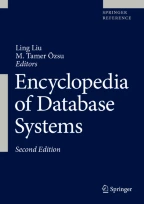Synonyms
Database replication; Replication
Definition
Using data replication, each logical data item of a database has several physical copies each of them located on a different node, also referred to as a site (typically a physical machine). Depending on the context and the type of replication architecture, the term replica can refer to one of the physical copies of a particular data item or to an entire site with all its data copies. Data replication can serve different purposes. Firstly, it can be used to increase availability and provide fault tolerance since the data can, in principle, be accessed as long as one replica is available. Secondly, it can provide low response times in wide-area settings. By storing replicas close to users that want to access the data, replication allows fast local access. Thirdly, access requests can be distributed across the replicas. When the incoming load increases, new replicas can be added to the system, achieving a higher throughput. Thus,...
Access this chapter
Tax calculation will be finalised at checkout
Purchases are for personal use only
Recommended Reading
Aguilera MK, Terry DB. The many faces of consistency. IEEE Data Eng Bull. 2016;39(1):3–13.
Almeida S, Leitão J, Rodrigues LET. Chainreaction: a causal+ consistent datastore based on chain replication. In: Proceedings of the 8th ACM SIGOPS/EuroSys European Conference on Computer Systems; 2013. p. 85–98.
Alonso G, Charron-Bost B, Pedone F, Schiper A, editors. Seminar: a 30-year perspective on replication. Monte Verita; 2007.
Bernstein PA, Hadzilacos V, Goodman N. Concurrency control and recovery in database systems. Reading: Addison Wesley; 1987.
Breitbart Y, Komondoor R, Rastogi R, Seshadri S, Silberschatz A. Update propagation protocols for replicated databases. In: Proceedings of the ACM SIGMOD International Conference on Management of Data; 1999. p. 97–108.
Budhiraja N, Marzullo K, Schneider FB, Toueg S. The primary-backup approach. In: Mullender S, editor. Distributed systems. 2nd ed. Reading: Addison Wesley; 1993. p. 199–216.
Cabrera L-F, Pâris J-F, editors. In: Proceedings of the 1st Workshop on Management of Replicated Data; 1990.
Corbett JC, Dean J, Epstein M, Fikes A, Frost C, Furman JJ, Ghemawat S, Gubarev A, Heiser C, Hochschild P, Hsieh WC, Kanthak S, Kogan E, Li H, Lloyd A, Melnik S, Mwaura D, Nagle D, Quinlan S, Rao R, Rolig L, Saito Y, Szymaniak M, Taylor C, Wang R, Woodford D. Spanner: Google’s globally distributed database. ACM Trans Comput Syst. 2013;31(3):8.
Kemme B, editor. Data consistency in the cloud. IEEE Data Eng Bull. 2015;38(1).
Kemme B, editor. Data consistency across research communities. IEEE Data Eng Bull. 2016;39(1).
Faleiro JM, Abadi DJ. FIT: a distributed database performance tradeoff. IEEE Data Eng Bull. 2015;38(1):10–7.
Gilbert S, Lynch NA. Brewer’s conjecture and the feasibility of consistent, available, partition-tolerant web services. ACM SIGACT News. 2002;33(2): 51–9.
Gray J, Helland P, O’Neil P, Shasha D. The dangers of replication and a solution. In: Proceedings of the ACM SIGMOD International Conference on Management of Data; 1996. p. 173–82.
Guerraoui R, Pavlovic M, Seredinschi D-A. Trade-offs in replicated systems. IEEE Data Eng Bull. 2016;39(1):14–26.
Li C, Porto D, Clement A, Gehrke J, Preguiça NM, Rodrigues R. Making geo-replicated systems fast as possible, consistent when necessary. In: Proceedings of the 10th USENIX Symposium on Operating System Design and Implementation; 2012. p. 265–78.
Lin Y, Kemme B, Patiño-Martínez M, Jiménez-Peris R. Middleware based data replication providing snapshot isolation. In: Proceedings of the ACM SIGMOD International Conference on Management of Data; 2005. p. 419–30.
Lv Q, Cao P, Cohen E, Li K, Shenker S. Search and replication in unstructured peer-to-peer networks. In: Proceedings of the 16th Annual International Conference on Supercomputing; 2002. p. 84–95.
Mahmoud HA, Nawab F, Pucher A, Agrawal D, El Abbadi A. Low-latency multi-datacenter databases using replicated commit. Proc VLDB Endow. 2013;6(9):661–72.
Röhm U, Böhm K, Schek H-J, Schuldt H. FAS - a freshness-sensitive coordination middleware for a cluster of OLAP components. In: Proceedings of the 28th International Conference on Very Large Data Bases; 2002. p. 754–65.
Saito Y, Shapiro M. Optimistic replication. ACM Comput Surv. 2005;37(1):42–81.
Satyanarayanan M, Kistler JJ, Kumar P, Okasaki ME, Siegel EH, Steere DC. Coda: a highly available file system for a distributed workstation environment. IEEE Trans Comput. 1990;39(4):447–59.
Schneider FB. Replication management using the state-machine approach. In: Mullender S, editor. Distributed systems. 2nd ed. Reading: Addison Wesley; 1993. p. 169–98.
Sivasubramanian S, Szymaniak M, Pierre G, van Steen M. Replication for web hosting systems. ACM Comput Surv. 2004;36(3):291–334.
Sovran Y, Power R, Aguilera MK, Li J. Transactional storage for geo-replicated systems. In: Proceedings of the 23rd ACM Symposium on Operating System Principles; 2011. p. 385–400.
Terry DB, Theimer M, Petersen K, Demers AJ, Spreitzer M, Hauser C. Managing update conflicts in Bayou, a weakly connected replicated storage system. In: Proceedings of the 15th ACM Symposium on Operating System Principles; 1995. p. 172–83.
Wiesmann M, Schiper A. Comparison of database replication techniques based on total order broadcast. IEEE Trans Knowl Data Eng. 2005;17(4):551–66.
Author information
Authors and Affiliations
Corresponding author
Editor information
Editors and Affiliations
Rights and permissions
Copyright information
© 2018 Springer Science+Business Media, LLC, part of Springer Nature
About this entry
Cite this entry
Kemme, B. (2018). Data Replication. In: Liu, L., Özsu, M.T. (eds) Encyclopedia of Database Systems. Springer, New York, NY. https://doi.org/10.1007/978-1-4614-8265-9_110
Download citation
DOI: https://doi.org/10.1007/978-1-4614-8265-9_110
Published:
Publisher Name: Springer, New York, NY
Print ISBN: 978-1-4614-8266-6
Online ISBN: 978-1-4614-8265-9
eBook Packages: Computer ScienceReference Module Computer Science and Engineering
